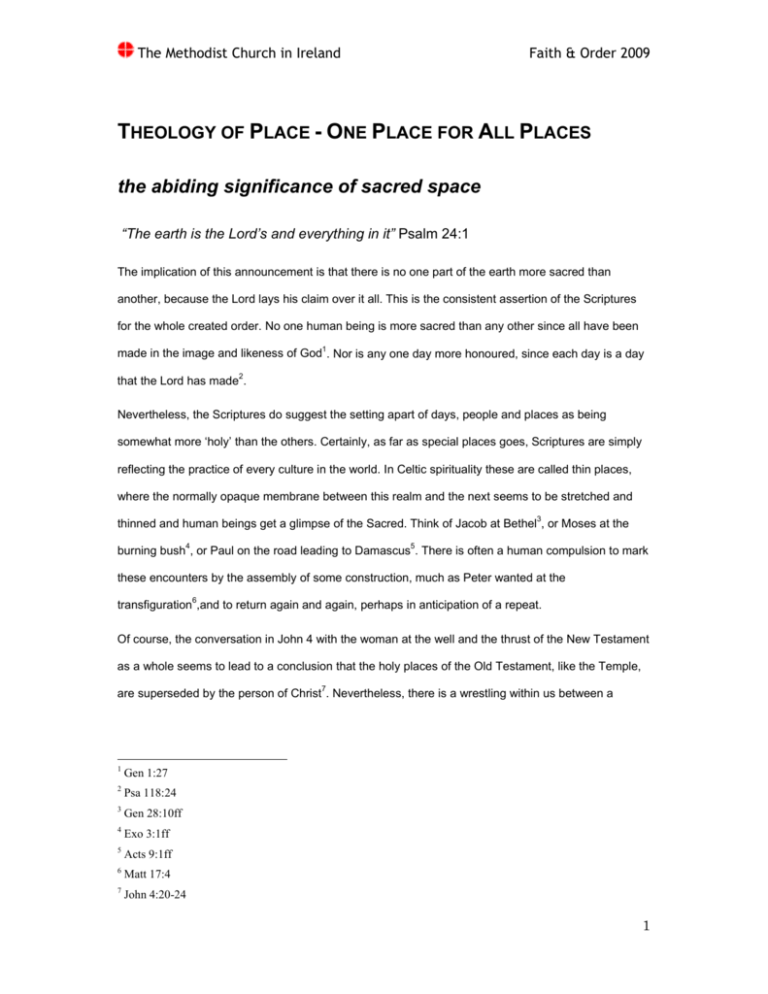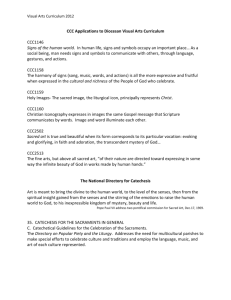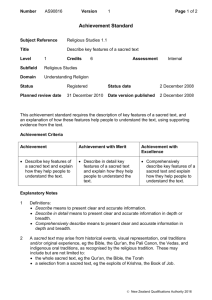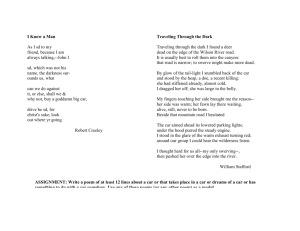the abiding significance of sacred space
advertisement

The Methodist Church in Ireland Faith & Order 2009 THEOLOGY OF PLACE - ONE PLACE FOR ALL PLACES the abiding significance of sacred space “The earth is the Lord’s and everything in it” Psalm 24:1 The implication of this announcement is that there is no one part of the earth more sacred than another, because the Lord lays his claim over it all. This is the consistent assertion of the Scriptures for the whole created order. No one human being is more sacred than any other since all have been made in the image and likeness of God1. Nor is any one day more honoured, since each day is a day that the Lord has made2. Nevertheless, the Scriptures do suggest the setting apart of days, people and places as being somewhat more ‘holy’ than the others. Certainly, as far as special places goes, Scriptures are simply reflecting the practice of every culture in the world. In Celtic spirituality these are called thin places, where the normally opaque membrane between this realm and the next seems to be stretched and thinned and human beings get a glimpse of the Sacred. Think of Jacob at Bethel3, or Moses at the 4 5 burning bush , or Paul on the road leading to Damascus . There is often a human compulsion to mark these encounters by the assembly of some construction, much as Peter wanted at the transfiguration6,and to return again and again, perhaps in anticipation of a repeat. Of course, the conversation in John 4 with the woman at the well and the thrust of the New Testament as a whole seems to lead to a conclusion that the holy places of the Old Testament, like the Temple, are superseded by the person of Christ7. Nevertheless, there is a wrestling within us between a 1 Gen 1:27 2 Psa 118:24 3 Gen 28:10ff 4 Exo 3:1ff 5 Acts 9:1ff 6 Matt 17:4 7 John 4:20-24 1 The Methodist Church in Ireland Faith & Order 2009 theological understanding which appears to prefer person over location, and the reality of those places which to us assume greater spiritual significance. 8 In Eugene Peterson’s memorable phrase, ‘all discipleship is local’ , worked out in particular places, whether rural, suburban or urban, along roads and streets and avenues and beside real flesh and blood neighbours. We simply cannot work out our faith dislocated from the world around us. Space really matters. And in an era in which contemporary church architecture offers us buildings stripped of religious symbolism lest they offend the seeker, and barely distinguishable from office blocks or shopping malls, where previously sacred rituals like those surrounding deaths and marriages can now happen anywhere, are we in danger of losing the importance of place as we surrender to the profanation of everywhere? And does it matter anyway? SACRED PLACE IN THE BIBLE The scriptures display a horror of ‘the trackless, formless waste’, the tohu wabohu of Genesis 1:2. In the first chapter of the Bible, therefore, God acts to bring order out of the chaos creating a garden that would eventually be shaped and worked by Adam and Eve. According to Genesis 2:15 God puts the man he had made into the garden in order to till it and take care of it. Eden was not to be end point for the man because it was a space without any history or sense of place. It was the responsibility of the human beings to till it and place their mark upon it, and by this action to story Eden and to set in motion the great journey towards the heavenly city. Later, to save himself from becoming a wanderer in the trackless wastes Cain disobeys God and builds the first city which he names Enoch after his first born son9. Likewise the wanderers who settle at Babel seek to bring some order to the wide open spaces in which they wandered by settling at one location to avoid being scattered10. Cain and the city builders at Babel set aside or sanctify a special place in the midst of open space in order to bring some coherence to their condition. This work of ‘storying’ a space, giving it shape and purpose, and bringing order to chaos is necessary because human beings cannot live in the formless and trackless waste. 8 Eugene Peterson, Christ Plays in Ten Thousand Places, pg 72ff 9 Gen 4:17 10 Gen 11:1-4 2 The Methodist Church in Ireland Faith & Order 2009 “The chaos of the homogeneity and relativity of profane space cannot sustain a world. A profane world is therefore…a contradiction in term: it lacks the form imposed on chaos to bring a world.”11 But the question remains about the nature of sacred space. Walter Brueggemann makes a distinction between SPACE and PLACE. He says that places are spaces which have historical meaning12. Tim Gorringe argues that people ‘ensoul’ and ‘en-story’ their places and over the course of time these places also then ‘en-soul’ the people13. In many ways he is expressing in spiritual terms what Winston Churchill said “We shape our buildings, and afterwards our buildings shape us.” It seems that despite ourselves we sanctify places, whether that place is as personal as the place of our first kiss, or as public as side of the road where we leave flowers marking the spot of a traffic accident, or as overtly-sacred as the place of baptism, burial or marriage. Place is to be distinguished from space, says Brueggemann because, “Place is a space which has historical meanings, where some things have happened which are now remembered and which provide continuity and identity across generations. Place is space in which important words have been spoken which have established identity, defined vocation and envisioned destiny. Place is space in which vows have been exchanged, promises have been made, and demands have been issued. Place is indeed a protest against the unpromising pursuit of space. It is a declaration that our humanness cannot be found in escape, detachment, absence of commitment, and undefined freedom.”14 Such a definition undoubtedly encompasses many of our church buildings. Furthermore, we are alerted to the possibility that we are in a dialectical relationship with our sanctified places. That as we define them by the history we attach to them, over time these places also serve to define us. Such places are therefore essential to Christian identity. But how are places made sacred? 11 T J Gorringe, A Theology of the Built Environment, p37 12 Walter Brueggemann, The Land, p5 13 Gorringe p38 14 Brueggemann p5 3 The Methodist Church in Ireland Faith & Order 2009 DEFINING SACRED PLACES Philip Bess in his book Till We Have Built Jerusalem—Archictecture, Urbanism and the Sacred uses the rubric of sacrament, which he describes as an action or object in which the sacred is present, to describe how places and objects become sacred. He argues that both space and the objects that define and occupy it are always at least potentially ‘sacred’ in either a present or an anticipatory sense15. • Sacred presence: in terms of epiphanies such as Job16 or Isaiah17, Jacob18 or Moses19. Such places are made ‘sacred’ not by the work or choice of individual human beings but by the sovereign choice of the Sacred to make a revelation in and through them. In this sense human beings lack the power to make spaces and objects sacred. • Sacred anticipation: spaces and objects may be made sacred when they are offered up (sacrificed) by human beings to the Sacred in the hope of their sanctification. Such a sacrificial action may be made in the sense of self-restraint or in the sense of lavish care and attention to the works of our minds and hands. There are therefore two poles, sacred presence (leading to the veneration of shrines) and sacred anticipation (expressing itself in the building of glorious cathedrals). But between these extremes are a myriad of sacred places which are defined by a history of either encounter or sacrifice, which Bess describes as sacred call and human response. Sacred presence does allow of course, for a revelation of the sacred in a mundane place like a car park or a shopping centre, for God always chooses to appear on his own terms. This is not to say though that therefore all shopping centres or car parks are intrinsically holy places. In fact, the likelihood is that if this did happen in such a place we would probably act much as Peter did at the transfiguration and seek to build a shrine in commemoration20. 15 Philip Bess, Till We Have Built Jerusalem, p65 16 Job 38:1ff 17 Isa 6:1ff 18 Gen 28:10ff 19 Exo 3:1ff 20 Matt 17:4 4 The Methodist Church in Ireland Faith & Order 2009 Sacred anticipation however, allows for the possibility that we could, in fact, build a sacred place as a response or an offering. Bess suggests six characteristics common to works of architecture designed and built to be sacred places21: 1. A sense of verticality: this, he says is grounded in our human nature where height (e.g. towers, domes and naves) and/or depth (e.g. tombs, grottos and crypts) are accorded sacred signficance; 2. Concern for light (and shadow), as emblematic of the immateriality of the sacred; 3. Care for and delight in the craftsmanship, durability and material particularity— characteristic of the intrinsic, created, immanent goodness of material things and their sacramental, redeemed, transcendent potential; 4. The conscious employment of mathematic or geometric systems as ordering devices signifying the ‘structure’ of the natural order and its rootedness in the sacred; 5. The aspiration to achieve a compositional and artistic unity, whether simple or complex; 6. A sense of hierarchy, that is, of sacred things (even if they are ‘plain’ and ‘ordinary’ things sanctified) being in either their grandeur or their humility exceptional. Bess laments current architectural practice when he writes in summary: “Opulently appointed commercial buildings and enormous retail complexes dominate the urban and suburban landscape. Churches, schools, libraries and other historically ‘sacred’ civic buildings are built meanly in out-of-the-way places, too frequently careless of the logic of construction and building materials. There is little sign of sacrifice in contemporary building, of lavishness expended unaccompanied by hard calculation of its potential return in dollars or prestige.”22 But why should we be interested any more in building sacred places? Surely we’re better erecting pragmatic buildings which are multi-use and which satisfy the demand for the largest space at the cheapest price and the quickest time? Is there any more a need for sacred spaces? 21 Bess, p73f 22 Bess p75 5 The Methodist Church in Ireland Faith & Order 2009 SACRED PLACES AS FIRSTFRUITS John Bergsma might argue that we need them for the sake of all our other spaces. He disagrees with those who say that sacred places should not be distinguished from common spaces because to do so limits the sacred to distinct times and places, and denies its influence on the entirety of life. Rather, he says, the removal of the distinction of sacred place has not led to the sanctification of all space, but to its profanation—now no place is sacred. Instead he describes the relationship between sacred and common space using the concept of firstfruits23. In Romans 11:16 Paul writes that ‘if the firstfruits are holy, so is the whole batch of dough’. What is significant here, Bergsma argues, is that the offering of the firstfruits was regarded as sanctifying the whole harvest. In the rest of the scriptures the principle of firstfruits is extended to Sabbath, by which we sanctify each day of the week24, to the Tabernacle, by which the whole Israelite camp was sanctified25 and to the tithe on material goods, by which blessing was brought upon one’s entire wealth26. In extending this principle to the dedication of time, space and material goods to God, there are profound implications for our church buildings. By sacrificially setting aside space dedicated to God, we are seeking to extend the blessing of God on the whole. This is a fascinating extension of Bess’s concept of sacred anticipation. The argument therefore would be that our communities, urban, suburban and rural, need our sacred places as the promise of blessing for the whole community. These places, as well as the communities that worship in them exist as a foretaste of the eschatological blessing that awaits the whole creation. Far from seeking to blend in with the surrounding architecture we should be deliberate in the creation of a different order of place. A place which, when entered, brings one into an alternative way of experiencing time and space, which opens one to the possibility of encounter with the Sacred, whose walls are soaked in the stories, prayers and songs of a community over generations and which testifies to the transformative power of the Gospel. 23 John Bergsma, Firstfruits and the Sanctification of Space, Sacred Architecture, Issue 7, Fall/Winter 2007, p20 24 Gen 2:1-3 25 Exo 40 26 Mal 3:7-12 6 The Methodist Church in Ireland Faith & Order 2009 About the Author: Mr. Glenn Jordan is the Director of the Skainos Project, (http://www.skainos.org/) the Urban Redevelopment Programme associated with East Belfast Mission (http://www.ebm.org.uk/ ). His experience in this has helped to shape his reflection on this subject and this reflection has in turn helped to shape the direction of the redevelopment. 7







